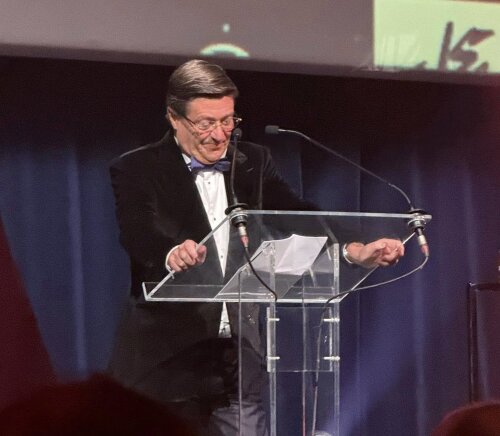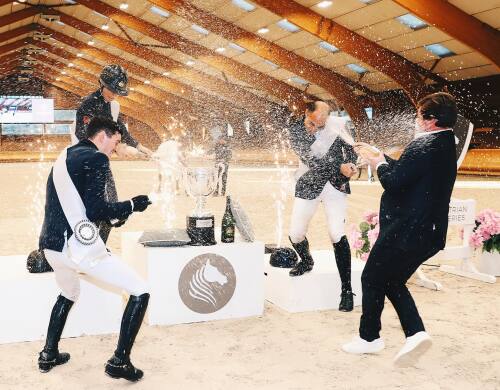It’s usually girls who long for a pony, and there’s no shortage of women at any stables. Why, then, do so few make it to the highest echelons of equestrian sport?
London on a gold-tinted, early- autumn evening, and the trio of elegant 1776 townhouses, on the northern side of Portman Square, are readying for their evening guests. Inside number 21, the Octagonal Dining Room, laid with starched white linen, crystal, silver and vases heavy with huge blue hydrangea blooms, is about to play host to 12 guests.
Suddenly, a gale of laughter fills the room, followed by a distinctly Aussie voice exclaiming, “Great to see you!” Katie Page, 57, the CEO of Harvey Norman, has spotted her first guest, champion Australian showjumper Edwina Tops-Alexander. Over the next hour, champagne in hand, she will greet a clutch of the world’s top female equestrians: trainers, showjumpers, Olympians and thoroughbred owners.
The last guests to arrive are Christiane “Criquette” Head-Maarek, a 66-year-old Frenchwoman widely acknowledged as being the leading female trainer in the world, and a relaxed Zara Phillips, the Queen’s granddaughter and 2012 Olympic silver medal winner.
Page, dressed in white Missoni and Calleija diamonds, takes her seat at the head of the table and, with an informal style unusual in these parts, explains that she’s invited the group to dinner to give equestrian women a chance to “chat, share stories and talk to each other”.
The dinner is also about her brainchild, Magic Millions Racing Women (MMRW), a campaign to champion the cause of women in the equine industry. In Australia, less than a quarter of racehorse owners are female, she says. Even fewer train at high levels, or work in decision-making positions within the industry and its regulators. Yet pay a visit to any stable before dawn or walk through a mounting yard on race day and there are young women everywhere.
At entry level, there is no shortage of females in the industry – strappers, track riders, stable hands. Why, then, do so few of them become trainers in charge of big stables? And this in equestrian sports, one of the very few arenas in which men and women can compete directly against one another.
For Katie Page and her husband of more than 20 years, Gerry Harvey, the plan to encourage more women owners and trainers was hatched in 1998, when they decided to buy Magic Millions, the Queensland-based thoroughbred yearling sale, and its associated racing carnival. Harvey owns several studs throughout Australia and New Zealand and about 1200 horses, among them 460 brood mares.
Page says they decided to buy Magic Millions to build the event into the most important auction and lucrative incentive race day on the Queensland calendar: “We wanted to make it as big as football.”
However, she’d already started to believe that some extra female action was needed. “Look, I’m a businesswoman and I do not go to the races for a glass of champagne. Already then, there was something about the thing that didn’t compute on the female side. I thought, ‘Well, what can we do to encourage women into this industry, to buy horses, to train horses, to race horses themselves?’ And I said to my husband those words he dreads: ‘I have an idea.’ ”
More than 15 years on, Magic Millions is the biggest thoroughbred yearling sale in the southern hemisphere. But it was only last year, says Page, that she enjoyed her “proudest moment” when the “idea” she’d mulled over for so long – a $500,000 incentive for women thoroughbred owners – was handed out on the Gold Coast at the Magic Millions Classic race for two-year-olds. “In my first year I worried we might not have any horses registered that qualified [for the MMRW bonus],” she explains. “So you can imagine how ecstatic I was when, last year, the first year of the women’s incentive race, eligible horses finished first, third and fourth. When Real Surreal [last year's winner] crossed the line in first place, I was overwhelmed – goosebumps and temporarily lost for words.”
Real Surreal’s winnings – $1,465,000, plus $325,000 of the $500,000 bonus incentive – were infused with an additional touch of magic because the filly had failed to sell at auction as a one-year-old. Her Queensland-based breeder, Michelle Lang-McMahon, a former Australian champion showjumper, decided to keep her, despite the lack of interest from buyers. Instead, she persuaded two female friends to take shares in Real Surreal. And so, when the unwanted horse managed to run down Gai Waterhouse’s Sweet Idea to win by a short neck, the fairytale was complete.
And who awarded Lang-McMahon her very welcome extra prize money? Zara Phillips, now the patron of Magic Millions Racing Women.
Edwina Tops-Alexander, MMRW ambassador and an Australian representative at the 2008 and 2012 Olympics, is sitting beneath a big red umbrella at the edge of the showjumping ring in Barcelona’s Royal Polo Club. The historic FEI Nations Cup showjumping series is under way and Australia is one of 40 nations battling for a spot. Prize money worth millions is up for grabs and Tops-Alexander is due to compete in less than an hour. Dressed in Gucci jodhpurs, shirt and handmade riding boots – the Italian fashion house is a long-time sponsor – Tops-Alexander exudes an easy, cool glamour and shows not an iota of pre-competition nerves.
Every week her email inbox pings with 10 or 15 earnest missives from horse-mad young girls who desperately want to be her when they grow up. “I really do try to write back to all the girls who contact me,” she says.
Tops-Alexander herself is a Sydney girl who grew up on a 1.2-hectare block in leafy North Turramurra, counted gymnastics among her many sports as a kid, and discovered her love of horses over the back fence, via the next-door neighbours’ ponies.
She remembers riding bareback, fearless even as an eight-year-old, before taking lessons, joining a pony club and, finally, competing in everything she could as a teen, from eventing to dressage, although jumping was her great talent. She understood early, however, that competing at an elite level requires elite quality – and enormously expensive – horses.
Desperate not to disappoint her parents, Tops-Alexander begged her coach to tell them she simply wasn’t good enough, so she could quit without explaining why. He refused, and she continued to ride while studying for a degree in physical sciences and working as a fitness instructor. Tops-Alexander was 24 before she finally headed overseas to test her ambitions.
She met her husband, Jan Tops, the Dutch Olympian and founder of the Global Champions Tour, when she took Australian clients to the Netherlands to look at his horses. Her career really took off when Jan offered her the opportunity to invest in a top-level horse, Pialotta, which she rode in the final of the World Equestrian Games in Aachen in 2006.
Today, Tops-Alexander is one of the great female equestrian success stories, with a stable of horses: she has just retired the showjumping champion Itot du Chateau, known affectionately as “Toti”. She describes the little chestnut as “a once-in-a-lifetime horse” and it was with him that she won the Global Champions Tour twice, in 2011 and 2012, and became the first woman to win more than a million dollars in prize money. Now an ultra-fit 40-year-old, she says she will continue riding competitively as long as her health allows – she competed in events on 48 weekends last year.
As ambassador for MMRW, she’s keen to share her philosophy: “Just this week I got a long email from a girl in Italy who desperately wants to ride competitively but her father wants her to study engineering, secure a future, find a job. I told her to show her dad her passion, to follow her ambition, but to study, too. ‘Show him you can compromise but don’t stop riding.’ ”
Back at Katie Page’s Japanese-themed three-course dinner, her “shequestrians” openly share anecdotes of their professional lives in a boy’s club. Head-Maarek – breeder and trainer of Trêve, the filly that beat all comers in the 2013 Prix de l’Arc de Triomphe in Paris, Europe’s richest race – describes typical contretemps working for male horse owners.
She talks about her behind-the-scenes push to convince Trêve’s owner, Sheikh Joaan al Thani, that his star filly should be allowed to race the Arc again this year. Despite the horse suffering an injury and an unexpected loss in April, “Criquette” was convinced Trêve could win again. Even more controversially, she wanted the Sheikh to agree to a different rider for the horse. He took her advice, not only allowing Trêve to race but allowing her to replace legendary Italian jockey Frankie Dettori with French veteran Thierry Jarnet.
On October 5, with the world’s cameras on her, Trêve vindicated Criquette’s gutsy decision – and the Sheik’s trust in his trainer – and was written into the racing history books by romping home with consecutive Arcs de Triomphe. “They say I’m a woman?” she exclaims over dinner. “Non, NON! I’m a trainer!”



